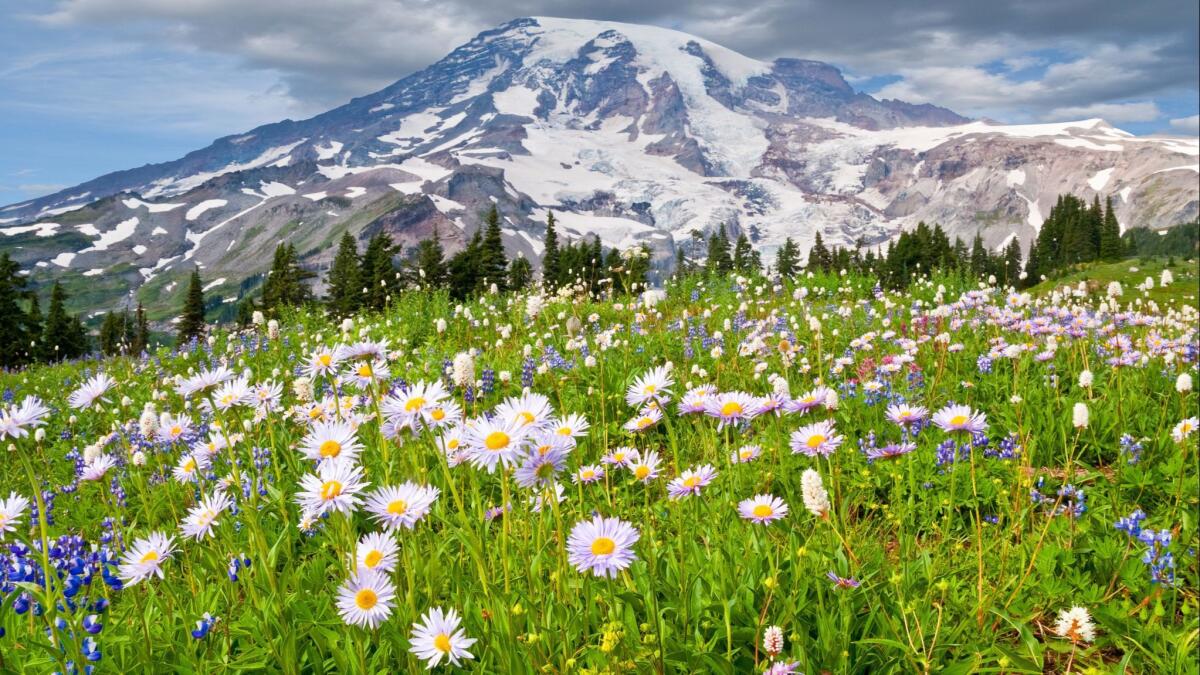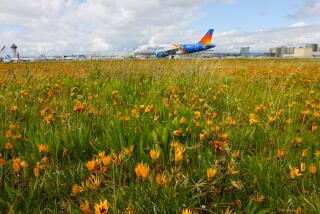Other Western states where wildflowers will put on a show this spring and summer
Wildflowers are on display as close to home as Griffith Park, but you also can go far beyond Southern California to find vibrant blooms. Here are eight states with wildflower destinations worth a road trip or a quick flight. Remember: Mother Nature can be unpredictable, so before you go, call or check the websites and social media pages of the places you want to visit. Many post weekly about current conditions.
Arizona
White Tank Mountain Regional Park, about 30 miles northwest of Phoenix, is one of the best places to see orange and red poppies. Short walks along Goat Camp and Mule Deer trails reveal poppies aplenty, and blue-purple lupine is visible along White Tank Mountain Road.
If you have the energy for an eight-mile loop, park supervisor Dove Luidhardt suggests parking at Area 7 and hiking up Mesquite Canyon Trail, across Ford Canyon Trail and down Willow Canyon Trail for stunning displays.
Luidhardt said to expect the flowers, along with fiddleneck and scorpion weed, to last at least through March — or longer if the area continues to receive rainfall and the temperatures are cool.
Picacho Peak State Park, about halfway between Phoenix and Tucson, “is experiencing some of the best blooms in 15 years,” said Michelle Thompson of Arizona State Parks & Trails. The park has been blanketed with pink globemallow, red chuparosa and other blooms since February. She also recommends Catalina State Park, north of Tucson.
If you can’t make it to those parks before April, head to higher elevations, because the cooler temperatures mean a later start to wildflower season. Both Oracle State Park, near Catalina, and Red Rock State Park in Sedona are expected to see blooms through May.
Colorado
Learn about the blooms July 5-14 at the Crested Butte Wildflower Festival. Sign up online for guided walks, photography classes, art workshops and more in the wildflower capital of Colorado. In Vail, the Walking Mountains Science Center offers guided wildflower walks daily in the summer.
Prefer independent exploration? Al Schneider, who has run a wildflower website for nearly 20 years, said you’ll find beautiful flowers almost anywhere in Colorado.
In the southwest, he recommended hiking Prater Ridge Trail in Mesa Verde National Park in mid-June.
Near Fort Collins, the Cathy Fromme Prairie Natural Area is home to bright yellow Nuttall’s violets, upright prairie coneflowers and narrowleaf stoneseeds from June to August.
West of Vail, the four-mile Shrine Mountain hike in White River National Forest is typically covered in wildflowers in July.
Nevada
If you like solitude and rough terrain, consider a road trip in a four-wheel-drive vehicle around Austin, a small town along U.S. 50 — also known as the Loneliest Road in America.
The area got a lot of moisture in late winter, so local wildflower enthusiast Kim Bozarth expects “a cacophony of color from late April until early September.”
Bozarth said you would see wildflowers driving along 50, but she also likes to drive south along Kingston Canyon Road to Groves Lake to see blooming chokecherry, wild geranium and lupine. She’s also seen orange globemallow and white prickly poppies along Birch Creek. To get there, take U.S. 50 to Nevada 376 and drive about 16 miles south. Google Maps won’t help you much in Austin, so visit the Chamber of Commerce for directions to flower heaven.
Oregon

Northern Oregon’s Columbia River Gorge has several family-friendly wildflower strolls off Interstate 84. Take an easy hike to Rowena Plateau to see yellow balsamroot, purple lupine and views of the gorge. The Tom McCall Preserve is on the same plateau where, beginning in May, you’ll find grass widow, buckwheat and shooting stars.
Drive west along the Hood River for a moderate hike to Mosier Plateau, covered in golden wildflowers from late April to early May.
Toward the coast, more than 300 species of flowering plants grow on Iron Mountain in the Willamette National Forest. You’ll break a sweat climbing to the top, but you can catch your breath and take in the columbine, yarrow and other blooms.
For flowers and an ocean view, head farther west to Marys Peak. It’s as high as you can get in the Oregon Coast Range, and its meadows are covered in Cardwell’s penstemon and lilies beginning in mid-April.
Texas
There’s more to enjoy in Austin than live music and breakfast tacos. The Lady Bird Johnson Wildflower Center’s 284 acres of gardens, trails and wildlands host pink evening primroses, purple coneflowers and famous Texas bluebonnets from March through May — and many other varieties in the summer.
Also in central Texas are bluebonnet-speckled McKinney Falls State Park and Wildseed Farms, which has 200 acres of bluebonnets, red corn poppies and more. Staff at both places suggest visiting in late March and early April for the best blooms.
If you’d rather explore wildflowers from the comfort of your air-conditioned car, you’re in luck; vast Texas has many wildflower drives. The 13-mile Willow City Loop starts near Fredericksburg and winds through the Hill Country, studded in the spring with bluebonnets, prickly poppies and phlox.
About 90 miles southeast of San Antonio, Cuero in wildflower-famous DeWitt County celebrates Wildflower Month in April. Stop by the Chamber of Commerce for a map of nearby wildflower drives.
Have time for a longer drive? A 230-mile loop from Marfa through Big Bend Ranch State Park reveals bluebonnets, desert marigolds and more among desert mountains in March and April.
Washington state

Mt. Rainier National Park has a dizzying number of wildflower sites, but Visit Rainier representatives say the Paradise and Sunrise areas have the best blooms. The paved Skyline Trail is a 5 1/2-mile-loop hike in Paradise, while Dege Peak in Sunrise offers flower views from one of the highest points of the park accessible by car.
For more leisurely viewing, ride the Mt. Rainier Gondola at Crystal Mountain Resort. Late July through mid-August is expected to be the best time to see the white avalanche lily, paintbrush and other wildflowers throughout the park.
Farther north, botanists at the Okanogan-Wenatchee National Forest suggest checking out the bluebell bellflowers and Indian paintbrush in Hart’s Pass from late June through July. It’s a high-elevation spot and it’s been a snowy year, so call the Methow Valley Ranger District for updates before you go.
The Forest Service also recommends five other wildflower viewing areas in the Okanogan-Wenatchee National Forest, including the Tiffany Botanical Area and Mad River Trail lditto.
Wyoming and Montana
You can’t go wrong with a visit to the first national park. Yellowstone has different elevations, so you’re bound to find wildflowers any time during growing season, but the widest variety can be found in mid-June and July.
“Some of my favorite places to go are Hayden Valley, Lamar Valley and Blacktail Plateau,” said Owen Carroll, a lead instructor at Yellowstone Forever, the park’s nonprofit partner. You might not even need to exit the car to see Yellowstone’s flowers because you can often find paintbrush, balsamroot, steer’s head and other blooms while cruising the Beartooth Highway.
Custer Gallatin National Forest lies just north of Yellowstone in Montana. Joanne Girvin of the forest’s Hebgen Lake District recommends stopping by the Earthquake Lake Visitor Center for the Earthshaking Auto Tour. You’ll stop at several flower-filled meadows, including wide-open Refuge Point, where you can spot glacier lilies, buttercups, sticky geranium and more from about mid-June to early July.
More to Read
Sign up for The Wild
We’ll help you find the best places to hike, bike and run, as well as the perfect silent spots for meditation and yoga.
You may occasionally receive promotional content from the Los Angeles Times.






